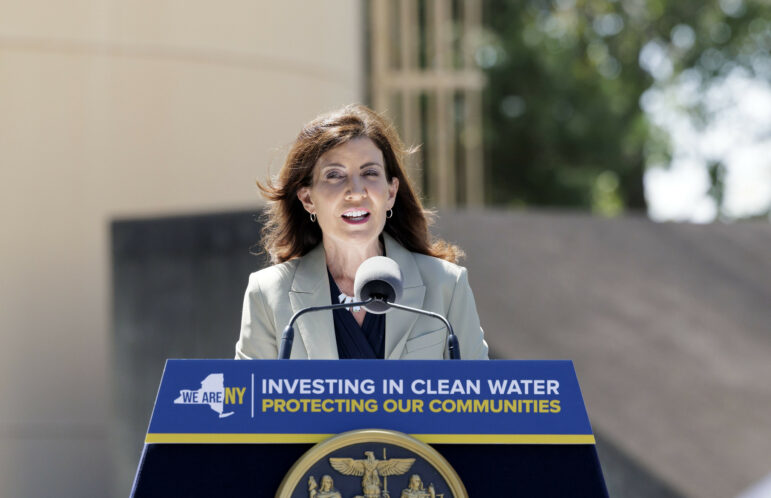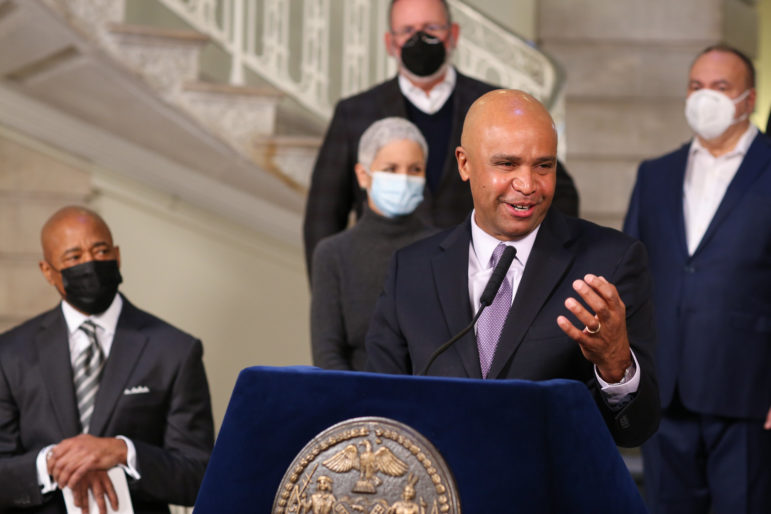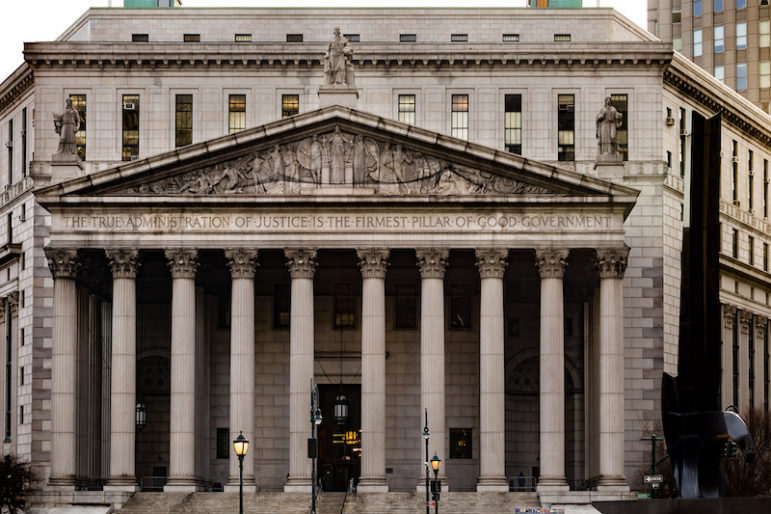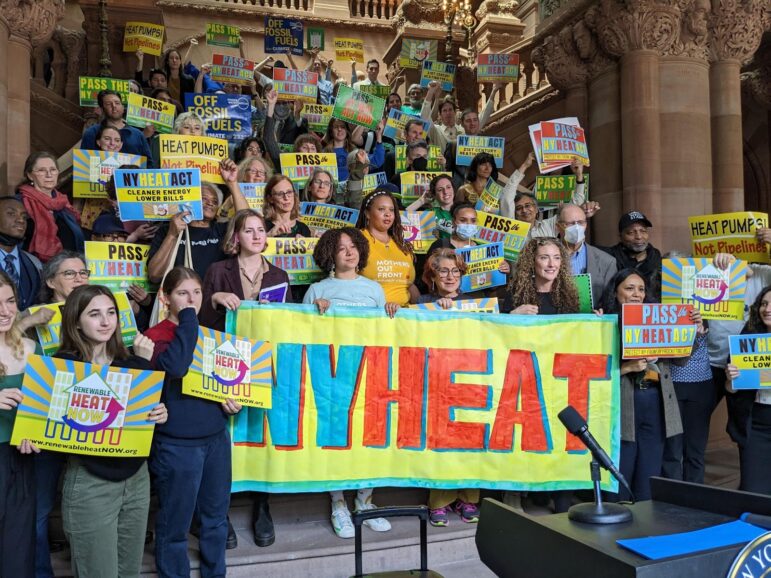“The state is twisting itself into legal pretzels to deny the Green Amendment’s ability to check government action that may be legally responsible for the violations of the environmental rights of New Yorkers.”

Mike Groll/Office of Governor Kathy Hochul
Gov. Kathy Hochul at a press conference in 2023.On Jan. 1, 2022, more than 70 prcent of New York voters cast their ballot in support of adding Article 1 Section 19—known as the New York Green Amendment—to the state constitution’s Bill of Rights.
The historic amendment recognizes and protects the rights of all New Yorkers to clean water and air and a healthful environment and places these rights on the same constitutional level as our other most cherished freedoms, such as the right to freely speak and to be free from unreasonable searches and seizures. With its passage, New York became the third state in the nation to give environmental rights this highest constitutional standing, joining Pennsylvania and Montana.
The reaction of Gov. Kathy Hochul, Attorney General Letitia James and the New York Department of Environmental Conservation (NYDEC) has been disappointing. Since the amendment took effect, it has been cited in just about a dozen cases in New York, including three challenges to government actions that have resulted in serious air pollution from industry and landfills.
In each of these three cases—involving the Norlite industrial operation in Cohoes, NY, the High Acres Landfill in Monroe County, and the Seneca Meadows landfill in Seneca County—the government is arguing against the Green Amendment’s power, claiming that it does not compel the government to affirmatively act to protect our environmental rights, despite the fact that these facilities could not operate but for government approval.
This view is mistaken. As these cases have advanced, we have seen the state’s position on the amendment emerge, take shape and evolve. While it has been good to see the state recognize that the NY Green Amendment “is an important addition to the Bill of Rights that protects individual rights against government intrusion,” it is unfortunate and disheartening that the state seems to deny its own ability and obligation to uphold and protect these rights.
In all three of these cases, the state is twisting itself into legal pretzels to deny the Green Amendment’s ability to check government action that may be legally responsible for the violations of the environmental rights of New Yorkers impacted by the permitted release of crystalline silica, greenhouse gases, hazardous air pollutants, and overwhelming noxious odors from industry and landfills. This pollution is harming the health of nearby communities, the success of local businesses, the property values of families and the ability of children to learn in school.
It worries me that the state is trying to turn the NY Green Amendment into a marketing ploy by asserting its strength and value on the one hand, while at the same time trying to undercut its legal viability by arguing that New Yorkers cannot use it to protect and enforce their environmental rights against government infringement.
Whether the NYDEC, attorney general or governor wish to recognize it or not, when it comes to the Norlite industrial operation, the High Acres Landfill, or the Seneca Meadows landfill, the State of New York’s permitting and ineffectual regulatory enforcement may be empowering air pollution and environmental desecration so extreme that it violates the rights of nearby communities to clean air and a healthful environment. Rather than allow impacted communities to make this claim in a court of law and back it up with facts and legal precedent, the state is seeking to have the cases dismissed.
Efforts to suggest that communities enforcing their environmental rights violates the separation of powers between our three branches of government misrepresents our system of checks and balances. It is the role of the courts to interpret the constitution and to take appropriate judicial measures to prevent unconstitutional government overreach that infringes on our constitutional rights.
In the New York cases advancing now, the plaintiffs are not seeking to displace the authority of any branch of government or agency. To the contrary, the impacted communities are simply exercising their legal right to engage the courts to ensure that the constitution is complied with and that the constitutional rights of the people are properly protected.
The people of New York—like those in states across the nation who are joining the Green Amendment movement to take back their ability to protect environmental rights, environmental justice, and climate protection—recognized that their government needed additional strength, guidance and oversight on environmental issues.
While new laws and regulations have improved the quality of our air, water and environment overall, for many communities—particularly people of color, lower income communities and indigenous communities—the promise of healthy water, air, soils, biodiversity, climate and environment remains elusive. This is what our Green Amendment was passed to protect.
New York’s passage of its Green Amendment was inspired by neighboring Pennsylvania, where communities used their Green Amendment rights to hold the state accountable to protect them from the invasion of fracking into residential communities. Montana’s Green Amendment was the powerhouse that allowed youth litigants to overturn a state law prohibiting government from considering the climate changing ramifications of their actions. Other cases have helped to address toxic soil contamination, water pollution, devastation of critical natural ecosystems, and both the human health and economic harms of environmental degradation.
As only the third state to pass a Green Amendment and give environmental rights the same standing as other fundamental freedoms such as speech, religion and property, the nation is closely watching New York to see what these Amendments can do.
All government authority is derived from the people, and it is the right of the people to amend their constitution to ensure that the government is properly exercising this grant of authority and does not infringe on their fundamental human rights—including the right to clean water and air, a safe climate and healthful environment.
In the final analysis, while a Green Amendment does create an obligation to protect the environmental rights of the people, it also provides a powerful tool for government officials to lift up and better protect our environment, to advance true environmental justice, and to stave off the climate crisis for the benefit of all people and all generations.
Over 20 other states are working towards this goal. Let’s be sure our New York government sends a message we can be proud of.
Maya K. van Rossum is founder of the national Green Amendments For The Generations movement and organization, author of “The Green Amendment, The People’s Fight For a Clean, Safe & Healthy Environment,” the Delaware Riverkeeper and a 30-year leader of the regional Delaware Riverkeeper Network.








